Physical Address
304 North Cardinal St.
Dorchester Center, MA 02124
Physical Address
304 North Cardinal St.
Dorchester Center, MA 02124
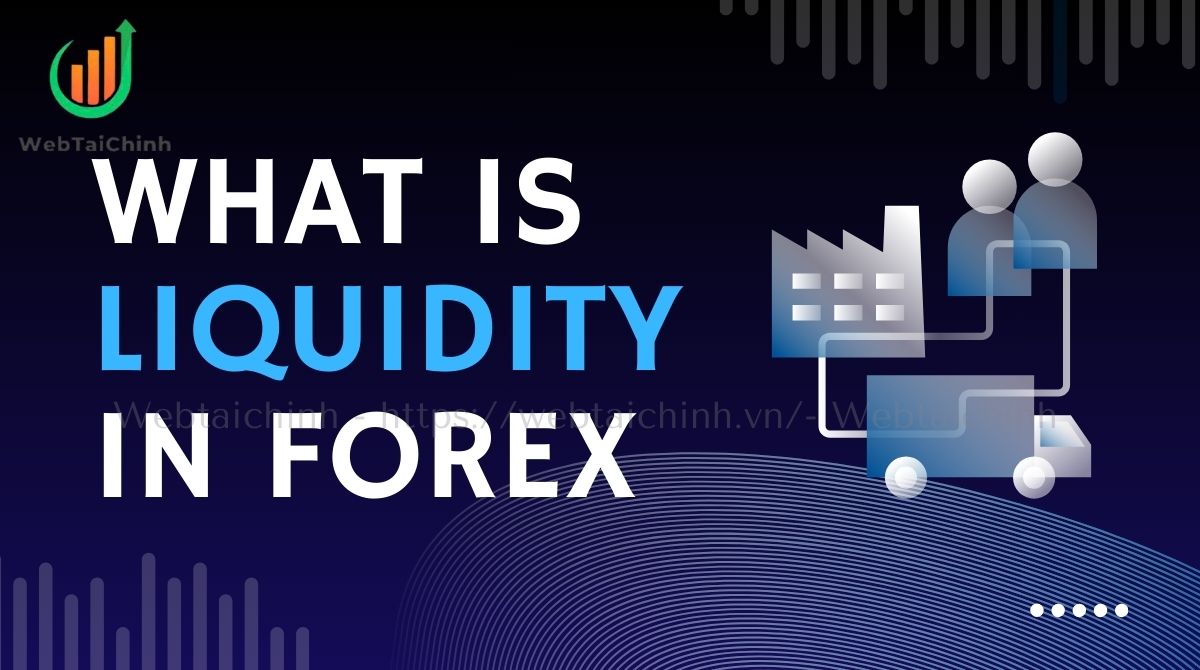
What is liquidity in forex and why does it matter so much for traders? Liquidity in forex refers to how easily a currency pair can be bought or sold without causing major price changes. For traders, this is a critical factor because it directly impacts transaction costs, execution speed, and risk management. High liquidity means tighter spreads and smoother trade execution, while low liquidity often leads to slippage, wider spreads, and sudden volatility.
At Webtaichinh, we’ll break down what liquidity in forex really means, why it’s important, and how you can adapt your trading strategies to different market conditions. By the end, you’ll know exactly how to use liquidity to reduce costs and manage risks more effectively.
Key takeaways:
When traders ask “what is liquidity in forex?”, the answer is simple: it’s the ability to buy or sell a currency pair quickly without causing significant changes in its price. In other words, liquidity measures how active and efficient a market is.
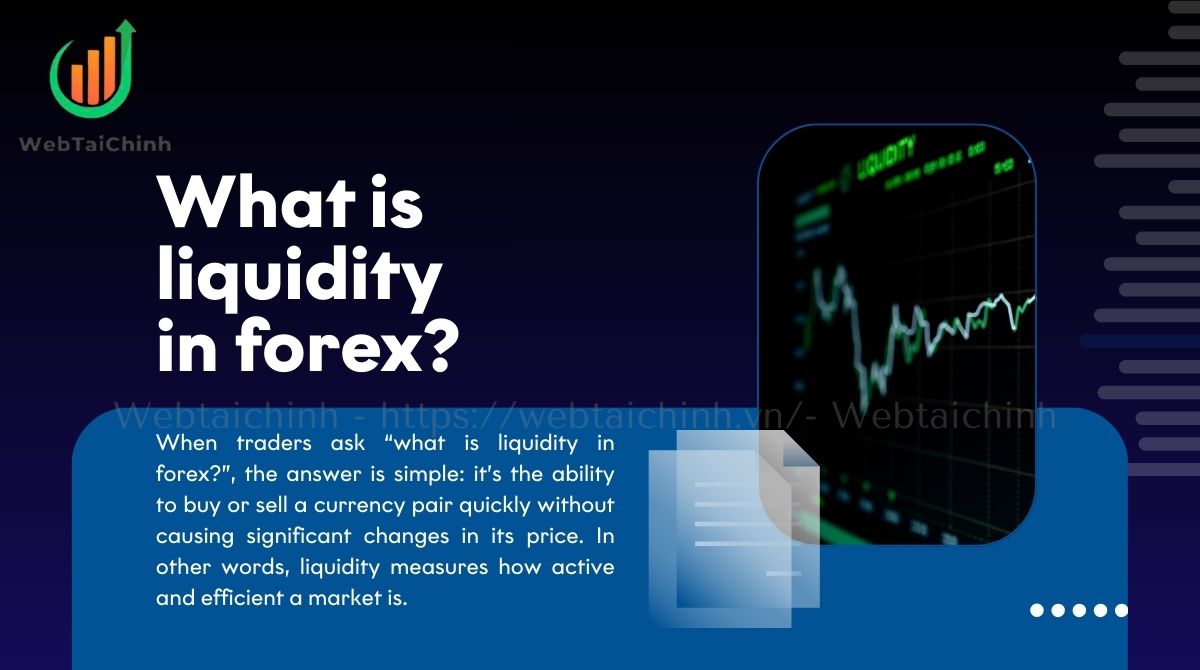
A highly liquid market means there are many buyers and sellers, so trades can be executed instantly at stable prices. For example, during peak trading hours, the EUR/USD pair is extremely liquid, offering tight spreads and fast execution. On the other hand, exotic pairs such as USD/TRY usually have lower liquidity, which results in wider spreads and slower order fills.
Core definition of liquidity in forex:
Liquidity: The ease of entering or exiting positions without heavy price impact.
Spread: The gap between the bid and ask price tighter in liquid markets.
Slippage: The difference between the expected and actual execution price.
Market depth: The available volume across different price levels.
Key takeaway: Liquidity in forex tells you how efficiently you can trade. The higher the liquidity, the smoother and cheaper your transactions will be.
Liquidity is one of the most critical factors in forex trading because it directly shapes trading costs, execution quality, and overall risk management. For both beginners and professional traders, understanding how liquidity affects each trade can mean the difference between consistent profits and unnecessary losses.
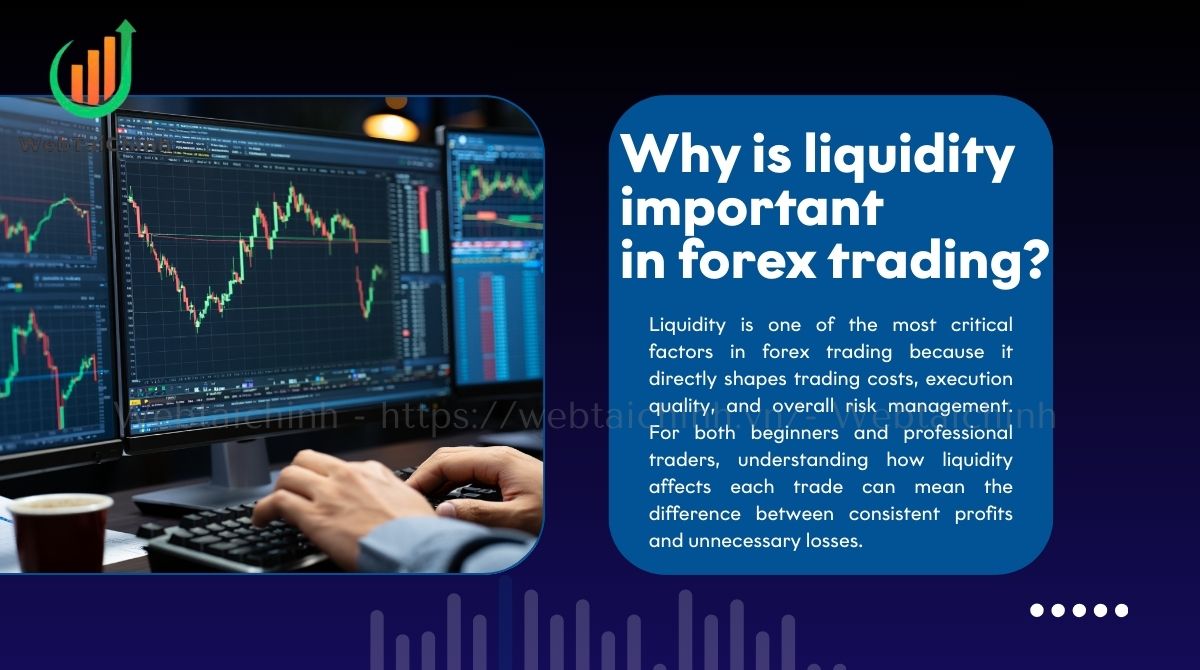
In highly liquid markets, spreads are tighter, meaning you pay less to open or close a position. Execution is also faster and smoother, reducing the chances of slippage. This creates a more predictable trading environment, which is crucial when applying short-term strategies like scalping or day trading.
By contrast, trading in low-liquidity conditions such as exotic currency pairs or during off-hours often leads to wider spreads, increased slippage, and sudden price spikes. These hidden costs can eat into profits, especially for traders who rely on precise entries and exits.
Expert insight:
Institutional traders and banks prefer high-liquidity pairs like EUR/USD or GBP/USD because their large orders can be absorbed without moving the market too much.
Retail traders often learn the importance of liquidity the hard way by entering a thin market and experiencing slippage that wipes out a significant portion of their expected gain.
Economic events such as Federal Reserve interest rate announcements temporarily reduce liquidity as market participants step back, leading to unpredictable volatility.
Benefits of high liquidity:
Tight spreads → lower transaction costs.
Fast execution → minimal slippage.
Greater market stability → reduced unexpected risk.
Risks of low liquidity:
Wider spreads → higher trading costs.
Higher slippage → worse execution than expected.
Volatility spikes → sudden stop-loss triggers.
What is liquidity in forex is not just about convenience it is a risk control mechanism. By focusing on highly liquid pairs and sessions, traders can optimize performance, reduce costs, and manage risk more effectively.
Liquidity is not the same across all currency pairs or trading sessions. Understanding the difference between high and low liquidity in forex helps traders decide when and what to trade for the best efficiency.
Major pairs like EUR/USD, USD/JPY, and GBP/USD are known for their high liquidity. These pairs attract heavy trading volume from institutions, banks, and retail traders worldwide, leading to tight spreads and consistent execution quality. This is why most traders prefer majors for day-to-day trading.
Minor pairs (for example, EUR/GBP or AUD/NZD) typically offer moderate liquidity. They can still provide good trading opportunities, but spreads are usually wider compared to major pairs, and liquidity fluctuates depending on the session.
Exotic pairs such as USD/TRY or USD/ZAR often experience low liquidity, especially outside peak hours. In these markets, even a relatively small order can move the price noticeably, resulting in higher slippage and increased volatility.
Trading sessions and liquidity levels
London–New York overlap (13:00–17:00 GMT): The most liquid period of the day, favored by both institutional and retail traders.
Asian session (00:00–09:00 GMT): Moderate liquidity, with better conditions for JPY-related pairs.
Off-hours and holidays: Liquidity drops significantly, making spreads wider and price movements less predictable.
Quick comparison table
| Currency type | Liquidity level | Example pairs |
|---|---|---|
| Major | High | EUR/USD, USD/JPY, GBP/USD |
| Minor | Moderate | EUR/GBP, AUD/NZD |
| Exotic | Low | USD/TRY, USD/ZAR |
In summary, high liquidity offers stability, low costs, and smoother execution, while low liquidity increases trading risks and transaction costs. Choosing the right pair at the right time is essential for consistent performance.
Knowing how to measure liquidity in forex is crucial for anticipating market conditions before placing a trade. Professional traders don’t just rely on intuition they use data and tools to evaluate market depth, spreads, and execution quality in real time.
Order book and market depth
A deep order book with large volumes at multiple price levels signals strong liquidity.
Thin books with little volume mean that even small trades can move the market.
Many institutional traders use ECN platforms to monitor depth before placing large orders.
Spread analysis
The spread between bid and ask prices is a quick proxy for liquidity.
Tighter spreads = higher liquidity, while wider spreads suggest reduced activity.
Traders often compare live spreads to their broker’s average historical spreads to spot unusual conditions.
Volume proxies
While forex is decentralized and doesn’t publish official volume, traders use tick volume, futures data (like CME currency futures), or broker-provided reports as liquidity indicators.
Consistent high tick volume during active sessions reflects strong liquidity.
Execution quality and slippage statistics
Tracking how often trades are filled at the expected price gives real-world insight into liquidity.
For example, if a EUR/USD market order fills instantly at the quoted price, liquidity is strong. If an exotic pair like USD/TRY shows repeated slippage or rejections, liquidity is weak.
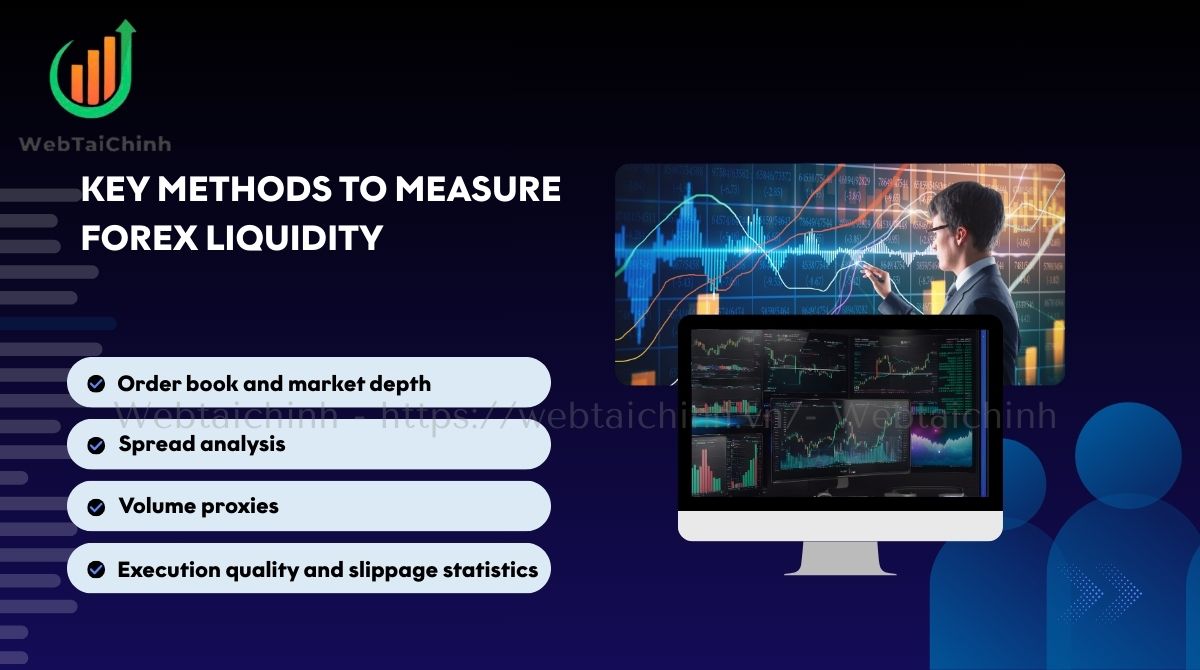
A day trader analyzing EUR/USD during the London–New York overlap might see spreads as low as 0.1 pips and minimal slippage. In contrast, the same trader checking USD/ZAR late in the Asian session could find spreads five times wider, shallow market depth, and multiple failed market order attempts.
The bottom line: Measuring liquidity isn’t about looking at a single indicator. It’s about combining order book depth, spreads, volume signals, and execution quality to build a clear picture of market conditions before committing capital.
Liquidity has a direct impact on how much traders pay to enter and exit the market. The main cost drivers are spreads, slippage, and price impact all of which are heavily influenced by liquidity conditions.
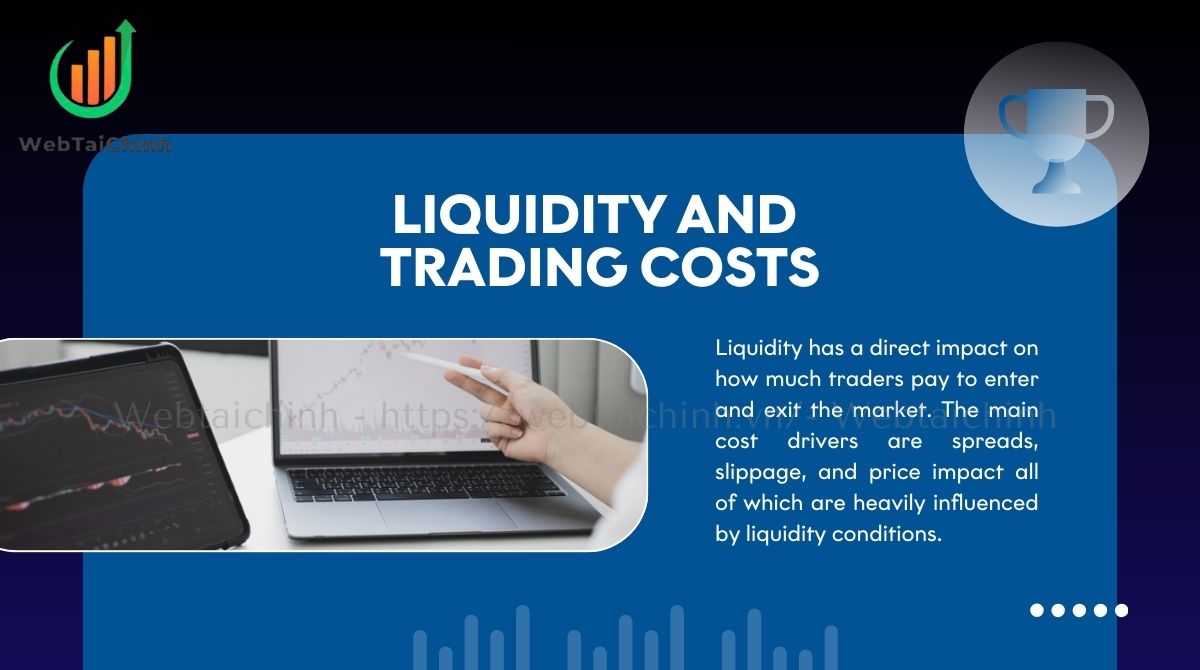
In highly liquid pairs such as EUR/USD, spreads are usually very tight (sometimes close to zero during peak hours). This keeps transaction costs low and allows for efficient short-term strategies. In contrast, exotic pairs like USD/TRY or USD/ZAR typically have wider spreads due to limited trading activity.
When markets lack liquidity, orders may not fill at the expected price. For instance, placing a large order in a thin market can push the price against you, creating a cost known as slippage. Scalpers and high-frequency traders are particularly sensitive to this.
In deep markets with high liquidity, large institutional trades can be absorbed with minimal price movement. But in thin markets, even relatively small trades can shift the market, making execution less predictable and riskier.
| Factor | High liquidity market (e.g., EUR/USD, peak hours) | Low liquidity market (e.g., USD/TRY, off-hours) |
|---|---|---|
| Spread | Very tight (0.1–0.3 pips) | Wide (5–20+ pips) |
| Slippage | Rare, minimal impact | Frequent, can be significant |
| Price impact | Large orders absorbed easily | Even small trades can move the market |
| Execution | Fast, reliable, minimal rejection | Slower, higher risk of partial fills |
This example highlights why knowing What Is Liquidity in Forex helps traders anticipate spreads and slippage in advance
In practice, a trader placing a €100,000 order on EUR/USD during the London–New York overlap might pay less than $30 in transaction costs. The same notional order in USD/TRY at night could cost several hundred dollars due to wide spreads and slippage.
Adapting your trading style to liquidity conditions is essential for reducing costs and managing risks effectively. Experienced traders don’t treat all market hours and currency pairs the same they adjust strategies depending on whether liquidity is high or low.
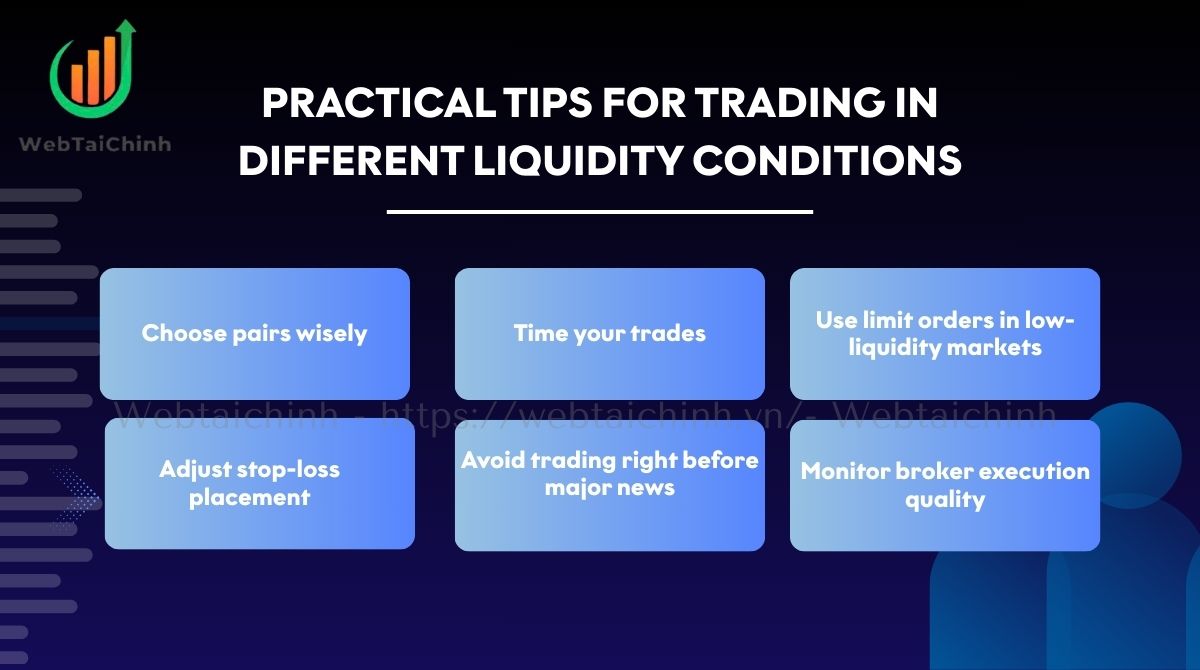
Stick to major pairs such as EUR/USD, USD/JPY, and GBP/USD during active sessions. These offer the tightest spreads and most reliable execution, making them ideal for day trading and scalping. Reserve exotic pairs for longer-term strategies where wider spreads are less impactful.
Trade during the London–New York overlap (13:00–17:00 GMT) for maximum liquidity.
Avoid off-hours or holidays when liquidity dries up, as these periods often bring erratic spreads and execution delays.
Market orders in thin markets are risky because slippage can be severe. A limit order ensures you only enter at your chosen price, even if it means waiting longer for execution.
In volatile, low-liquidity environments, stop-losses that are too tight may trigger prematurely due to sudden price spikes. Give your trades slightly more breathing room or use ATR (average true range) as a guide to set stops dynamically.
Liquidity often disappears just before high-impact announcements like FOMC decisions or NFP reports. Spreads widen dramatically, and slippage risk skyrockets. Professional traders typically wait until liquidity returns after the initial reaction.
Not all brokers provide the same liquidity access. Comparing slippage statistics, order rejection rates, and execution speed can help identify whether your broker has strong connections to liquidity providers.
In short, traders who align their strategies with liquidity conditions by choosing the right pairs, timing trades carefully, and using smarter order types can significantly reduce costs and avoid unnecessary risks.
Beyond basic spreads and slippage, advanced traders pay attention to liquidity gaps and the broader market microstructure. These factors explain why price sometimes behaves erratically, even in normally liquid markets.
A liquidity gap occurs when there are no orders available at certain price levels. This creates sudden jumps prices “gap” to the next available level. Liquidity gaps are common:
Around major news releases, when many participants cancel pending orders to avoid risk.
During low-volume periods, such as holidays or after market close in New York.
In exotic pairs, where order books are naturally thin.
Example: A large sell order on USD/TRY in a quiet session can consume all available bids at current levels, forcing the price to drop sharply to the next pocket of liquidity.
Market microstructure refers to the mechanics of how orders are placed, matched, and executed. It includes factors like:
Order book depth: Determines how much volume can be traded before prices move.
Latency: Small execution delays can cause slippage in fast-moving markets.
Liquidity providers: Banks, hedge funds, and market makers that ensure continuous pricing.
Professional traders often study market microstructure to understand why prices react differently in high vs. low liquidity environments. For instance, during the London–New York overlap, liquidity providers compete aggressively, which narrows spreads. Conversely, in off-hours, fewer providers remain active, so costs rise and execution quality falls.
Liquidity gaps often amplify volatility. When fewer orders are available, even small trades can trigger outsized moves. This explains why volatility spikes are common in thin markets, despite no major news catalyst.
Studying real scenarios helps traders see how liquidity directly shapes execution, costs, and risk exposure. Below are some practical examples from the forex market:
During the overlap between London and New York sessions, EUR/USD often has spreads as low as 0.1 pips. When a breakout occurs at this time, traders benefit from:
Tight spreads → lower costs when entering quickly.
Fast fills → market orders execute almost instantly.
Stable depth → large orders don’t cause sudden price jumps.
This environment allows breakout traders to capitalize on momentum without excessive slippage.
In contrast, trading exotic pairs like USD/TRY during low-liquidity hours is riskier. A trader placing a medium-sized order might see:
Spreads widen to over 20 pips.
Slippage adds further cost as orders fill at worse prices.
Price volatility spikes unexpectedly due to thin order books.
This scenario highlights why liquidity conditions must always factor into risk management.
Just before high-impact events such as the U.S. Non-Farm Payrolls (NFP) release, many liquidity providers pull their orders, causing spreads to widen drastically. A market order placed seconds before the announcement can experience heavy slippage. However, liquidity usually returns shortly after, stabilizing spreads.
Experienced traders either step aside until conditions normalize or use limit orders placed in advance to avoid unpredictable fills.
In summary, liquidity is not static it shifts by session, pair, and event. Traders who adapt to these changes can avoid unnecessary costs, while those ignoring liquidity risk often face poor fills and volatile losses.
Start your next learning step here:
Liquidity in forex is the ease of buying or selling a currency pair without moving its price significantly. It matters because it affects spreads, execution speed, and risk management core factors that determine trading costs.
Major pairs like EUR/USD, USD/JPY, and GBP/USD are the most liquid because they have the highest trading volumes and strongest participation from banks and institutions.
Liquidity peaks during the London–New York overlap (13:00–17:00 GMT). This period brings together the largest number of market participants, resulting in tighter spreads and faster order execution.
Low liquidity leads to wider spreads, frequent slippage, and higher volatility, all of which increase transaction costs. Exotic pairs and off-hours trading are especially prone to these conditions.
Yes. The forex market is the most liquid financial market in the world, with over $7 trillion traded daily. While stocks and crypto can also be liquid, forex generally offers deeper order books and tighter spreads.
Understanding what Is Liquidity in Forex is fundamental for every trader because it directly influences trading costs, execution quality, and risk exposure. Whether you are scalping major pairs during peak sessions or exploring exotic currencies, liquidity determines how efficiently your strategy performs.
Quick recap:
Liquidity in forex = ease of trading without heavy price impact.
High liquidity brings tight spreads, faster execution, and more stable conditions.
Low liquidity creates wider spreads, higher slippage, and sudden volatility.
Liquidity varies by currency pair, trading session, and global events.
Measuring spreads, market depth, and execution quality helps traders adapt strategies.
What about you have you ever experienced slippage or unexpected costs because of low liquidity? Share your thoughts or questions in the comments, and let’s discuss how traders can handle these challenges more effectively.
Web Tai Chinh is a portal that updates news and information related to finance quickly and accurately, helping users have an overview before investing, clearly understanding concepts and terms related to Finance. Explore more insights in our Forex category, start your FX trading journey today with the right partner for long-term success.
📞 Contact: 055 937 9204
✉️ Email: webtaichinhvnvn@gmail.com
📍 Address: 13 Ho Tung Mau, An Binh, Di An, Binh Duong